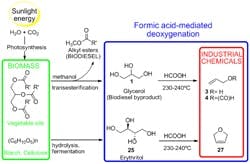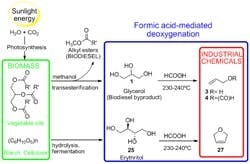Bio-based Route for Allyl Alcohols Beckons
Growing production of biodiesel is raising concerns over what to do with all the byproduct glycerol (see, e.g., “Gylcerol Girds for New Role,” and “Consortium Targets Biodiesel Byproduct”). The answer may be in using gylcerol to make allyl alcohol, a feedstock for numerous chemical products, say researchers at the University of California, Berkeley, Calif., and the U.S. Department of Energy’s Lawrence Berkeley National Laboratory, Berkeley, Calif.
“We’ve found and optimized a selective, one-pot deoxygenation technique based on a formic acid treatment [Figure 1],” notes Robert Bergman, who holds a joint appointment in the university’s Chemistry Department and the Lab’s Chemical Sciences Division. “Our preliminary results with inexpensive biomass-derived polyols suggest that the reaction of polyhydroxy compounds with formic acid will be a viable alternative for the manufacture of reduced oxygen content products,” he adds.
The formic-acid-mediated conversion of gylcerol already has achieved allyl-alcohol yields of 84% in bench-scale (500-g) tests.
Figure 1. Deoxygenation process relies on nitrogen to prevents charring.
Source: Lawrence Berkeley National Laboratory.
“The reaction is very clean — we only see allyl alcohol and the corresponding formate, which can be easily hydrolyzed back to pure alcohol,” Bergman states. The route avoids problems of charring, i.e., unselective combustion, that have depressed yields in earlier work. “Treating glycerol with formic acid while directing a stream of nitrogen through the reaction mixture completely eliminates charring. Besides protecting the product from atmospheric oxidation, the nitrogen also facilitates distillation of the alcohol. The final product shows substantially improved yield and higher selectivity,” he explains. The researchers also report promising preliminary results with sugar alcohols. Yields can reach 77% for production of 2,5-dihydrofuran from erythritol. More details appear in a recent paper in Chemical Communications.
“From our studies we gained a much better understanding of the basic chemistry behind the reaction… We uncovered an unexpected reaction pathway that really broadens the generality of this reaction and expands its potential applications,” adds Jonathan Ellman, a Berkeley chemistry professor who is co- principal investigator. Besides handling other polyhydroxyl compounds, the process can convert carbohydrates in biomass.
“Our main goal right now is to extend the scope of the reaction to other biofeedstocks, e.g., polyhydroxy compounds derived from sugar,” notes Bergman. “There are a lot of potential starting materials to explore.”
“One key challenge is the cost of formic acid but we and others are making progress on the solution to that problem,” he says.
“Scaling the technique up to industrial levels is probably going to require the combined efforts of industrial and academic laboratories,” notes Ellman. Dow Chemical Co., Midland, Mich., has supported the work so far and has expressed strong interest in it, Bergman adds.

